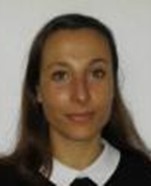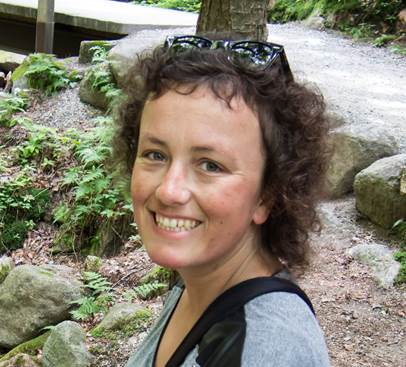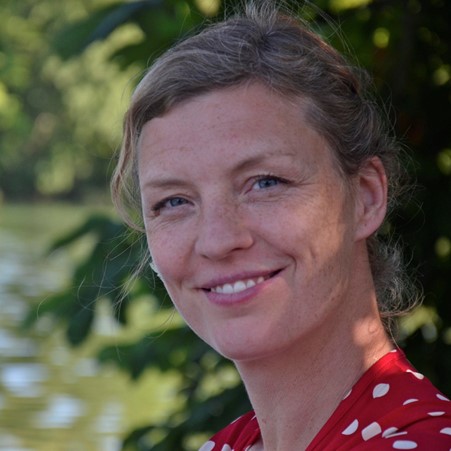
Bienvenue aux nouveaux arrivants dans l'UMR BOREA !
- Emilie Réalis, ATER, is in Team 2, at University of Caen, since September 1st 2018.

Research Topics: « Etude des réseaux neuroendocriniens via l' identification de couples récepteurs/ligands »
« My research project fit into NEMO "NEuropeptides of Marine Organisms", a Franco-Taïwanese project supported by ANR and NSC for a duration of 4 years (2015-2019). This project aims to explore the evolution of endocrine systems and to investigate their role in the regulation and plasticity of biological cycles and the reproduction of unconventional model animals (eel, oyster, cuttlefish, coral) of phylogenetic, ecological and economic interest in a context of global change.
My role in this project is to characterize receptor / ligand couples in connection with the reproduction of the cupped oyster Crassostrea gigas. I am interested in oyster receptors phylogenetically related to vertebrate Kisspeptin receptors. These receptors being orphan in Protostoma, a reverse endocrinology methodology will be implemented to identify their oyster neuropeptide ligands ».
Contact: emilie.realis-doyelle@unicaen.fr
- Juliette Delavenne, Post doc, joined Team 7, in Paris (MNHN) since December 1st, 2018.

Research Topics: « Valorisation of natural history collections and natural expeditions for the conservation and management of deep environments: the unique case of the Tropical Deep Sea Benthos program »
« My research mainly focuses on identifying and explaining marine biodiversity patterns at community and habitat scale to better manage and conserve these threatened ecosystems. I have studied different ecosystems and a range of marine taxa with always a central question: How the data quality and resolution influence diversity patterns and how these patterns variations could impact conservation planning outputs or management measures?
I started my career working on temperate seas (benthic and pelagic habitats and then mobile megafauna) and systematic conservation planning approaches in French national waters. I now focus on tropical deep sea environments and especially seamounts (New Caledonia, Mayotte, French Polynesia…), describing their biodiversity patterns and characterizing them for a better management and conservation.
My postdoc project will last two years and will use the museum collections from the Tropical Dee Sea Benthos program (TDSB) to characterize the deep sea biodiversity patterns in the indo pacific region for multiple taxa. Robust statistics will be developed to analyze these data and to explore the relative influence of environmental and historical factors in the biodiversity patterns. Expected results will allow identifying and hierarchizing deep sea areas sensitivity to human impacts. This postdoc is financed by the BCDIV labex and co-supervised by Sarah Samadi, Boris Leroy and Maud Mouchet ».
Contact: juliette.delavenne@mnhn.fr
- Aurore Raoux, Aurore Raoux, having supported his doctoral thesis on November 27th, 2017, pursues his searches in the team 5, in Caen on a post-doctorate within the project TROPHIK since December, 2017 for a period 3 months.

Research Topics: « Des modèles de réseaux trophiques à la décision politique : quelles leçons tirer des simulations de cumul d’impacts en Baie de Seine ? (TROPHIK)»
Contact: aurore.raoux@unicaen.fr
- Matilda Haraldsson, Post doc for one year, in in Teams 5 and 7 in Paris (MNHN), since January 2nd 2018.

Research Topics: « What does the public think about wind farms? What are their concerns and what are their expectations? And how can their opinion influence the network of ecological and human actors?»
In this project I will address these types of questions by modeling the socio-ecological system of the Bay of Seine, with a focus on the network of actors related to the construction of the windfarm in Courseulles-sur-Mer. More specifically I will use qualitative network analysis, stability analyses and Bayesian belief networks to mathematically analyze the network of ecological and human actors. To do this, I have in my hand information on the ecological network interactions derived from Ecopath models of the Courseulles-sur-Mer’s ecosystem (information originating from Aurore Raoux’s PhD thesis). I will also use information about the network of human actors obtained by questionnaires and surveys (information originating from Camille Mazé (anthropologist at LEMAR and APOLIMER) and the RETROPOLI project).
This work is part of the project TROPHIK (Ecosystem approach of MRE (Marine Renewable Energy): modeling the role of offshore wind farms in modifying the functioning of coastal food webs and cumulative impacts) ».
Contact : matildaharaldsson@gmail.com
- Jérôme Morelle, Having supported its doctoral thesis November 30th, 2017, pursues its searches researches in the Team 5, in Caen on a post-doctorate within the project PHARESEE, since January 1th, 2018 for a period of 15 months.

Research Topics: « Productivité microphytobenthique des HAbitats intertidaux en lien avec la dynamique sédimentaire, biogéochimique et les ingénieurs d'écosystème de la faune benthique: implication pour des enjeux de modélisation et de REhabilitation des vasières de la SEine Estuarienne (PHARESEE) »
« Mes travaux de recherche in situ se basent principalement sur l’estimation de la production primaire du phytoplancton et du microphytobenthos. En effet, la production primaire est fortement soutenue par ces deux compartiments. Cependant cette production est très variable en fonction des paramètres environnementaux à faible échelle spatiale et temporelle. Ainsi l’un des objectifs principaux de mes études est la mesure de production primaire à haute fréquence spatio-temporelle. Pour cela, j’utilise notamment le couplage des méthodes d’incorporation du carbone et de mesure des paramètres photosynthétiques basée sur la variation de la fluorescence en utilisant des fluorimètres de type PAM (Pulse Amplitute Modulated). Le couplage de ces deux méthodes permet de connaître la déterminer le nombre de moles d’électrons nécessaire à la fixation d’une mole de carbone et de transformer les données de fluorescence à haute fréquence en unités de carbone. Cependant ce paramètre est dépendant des paramètres physico-chimiques, physiologiques et biologiques.
Mon travail se base également sur l’étude des excrétions de carbone sous forme d’exopolysaccharides dont l’estimation des stocks issus de la production primaire est importante lors de l’étude des flux de carbone au sein des réseaux trophiques. En effet, malgré l’importance des TEP et des EPS dans les processus physiques et biologiques, seules peu d’études se concentrent sur ces fractions biogéochimiques lors de l’appréhension de la production primaire. D’autant plus que ce stock de carbone peut être très important. Cependant ces stocks varient également de façon importante en fonction des paramètres biologiques et environnementaux à l’échelle spatiale et temporelle autant dans la colonne d’eau que sur les zones intertidales.
Mes activités de recherche se penchent également sur la diversité du phytoplancton à partir d’analyses de détermination par microscopie optique sur différentes espèces de diatomées et de dinoflagellé. Mais également à partir de nouvelles méthode d’identification de la diversité par l’utilisation des techniques de cytométrie en flux et de biologie moléculaire dont les résultats permettent d’accéder à différents aspects de la diversité. La dynamique de succession de ces différentes espèces a ainsi pu être mise en relation avec les paramètres environnementaux et les dynamiques de la production de carbone via la photosynthèse et l’excrétion de polysaccharides.
Parallèlement à mes travaux in situ, mes travaux in vitro m’ont permis de maitriser l’isolement de cellules à partir d’échantillons naturels et la mise en place de cultures monoclonales pour différentes espèces de diatomées et de dinoflagellés. Ceci m’ayant notamment permis d’étudier l’effet des variations du cycle nycthéméral de la lumière sur la productivité primaire mesurées à haute fréquence ou encore l’effet de la température sur la physiologie de la diatomée toxique pseudo-nitzschia australis ».
Contact : jerome.morelle@unicaen.fr
